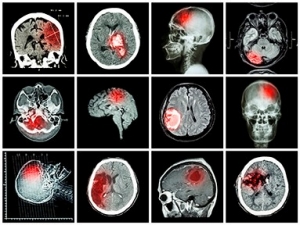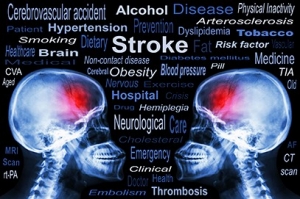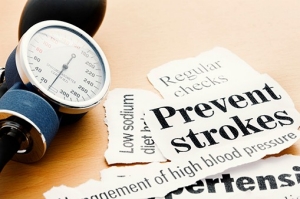Stroke
Stroke is a type of cardiovascular disease which occurs as result of blockage of blood vessel supplying oxygen and nutrients to the brain. This blockage could happen either by a clot or bursts impairing enough supply of oxygenated blood to the effected part which in turn starts to die. Almost every 45 seconds an American gets a stroke.

A stroke (brain attack) happens when the blood supply to part of your brain is interrupted or blocked. When this occurs, the brain is not getting the proper levels of oxygen and nutrients. Within minutes, brain cells begin to die. A stroke is a medical emergency. Early, quick treatment is critical. Early action can reduce brain damage and other potential complications.
Types of Stroke
Ischemic Stroke: About 85 percent of strokes are ischemic strokes. Ischemic strokes happen when the arteries to your brain become narrowed or blocked, causing severely reduced blood flow (ischemia).
Hemorrhagic Stroke: Hemorrhagic stroke happens when a blood vessel in your brain leaks or breaks. Brain hemorrhages result from many conditions that affect your blood vessels, including uncontrolled high blood pressure (hypertension), overtreatment with anticoagulants (medicines that prevent blood clots/blood thinners) and weak spots along your blood vessel walls (aneurysms).
Transient Ischemic Attack (TIA)/Mini-stroke: Like an ischemic stroke, a TIA happens when a clot or debris blocks blood flow to part of your brain. A TIA doesn't usually leave lasting symptoms because the blockage is temporary. TIAs usually last less than five minutes.

Some traits, conditions, behaviors and habits can raise your risk of having a stroke or transient ischemic attack (TIA). These traits, conditions, behaviors and habits are known as risk factors.
The more risk factors you have, the more likely you are to have a stroke. You can treat or control some risk factors, such as high blood pressure and smoking. Other risk factors, such as age and gender, you can’t control.
Lifestyle (behavioral) Risk Factors
- Being overweight or obese
- Physical inactivity
- Heavy alcohol use or binge drinking
- Use of illegal drugs such as cocaine, methamphetamines, heroine, etc.
Medical Risk Factors
- High blood pressure (hypertension)- Stroke risk gets higher with blood pressure readings above 120/80 millimeters of mercury (mm Hg). Your doctor will help you decide on a target blood pressure based on your age, whether you have diabetes and other factors.
- Cigarette smoking or exposure to secondhand smoke
- High cholesterol ; High Blood Pressure and Cholesterol- What You Need to Know (CDC Podcast)
- Diabetes
- Obstructive sleep apnea- a sleep condition in which the oxygen level irregularly drops during the night.
- Cardiovascular disease (including heart failure, heart defects, heart infection or abnormal heart rhythm).
Other Factors Associated With A Higher Risk of Stroke Include
- Personal or family history of stroke, heart attack or transient ischemic attack (TIA).
- Being age 55 or older.
- Race- African-Americans have a higher risk of stroke than do people of other races.
- Gender- Men have a higher risk of stroke than women. Women are usually older when they have strokes, and women are more likely to die of strokes than are men. Also, women may have some risk from taking birth control pills or hormone therapies that include estrogen, as well as from pregnancy and childbirth.

F.A.S.T. is an easy way to remember the sudden signs of stroke. When you can spot the signs, you need to call 9-1-1 for help right away.
If you notice any of these signs & symptoms-- Think "FAST"
F Face Drooping – Does one side of the face droop or is it numb? Ask the person to smile. Is the person's smile uneven?
A Arm Weakness – Is one arm weak or numb? Ask the person to raise both arms. Does one arm drift downward?
S Speech Difficulty – Is speech slurred? Is the person unable to speak or hard to understand? Ask the person to repeat a simple sentence, like "The sky is blue." Is the sentence repeated correctly?
T Time to call 9-1-1 – If someone shows any of these symptoms, even if the symptoms go away, call 9-1-1 and get the person to the hospital immediately. Check the time so you'll know when the first symptoms appeared.

Effects of Stroke
The effects of a stroke depend on the location of the obstruction and the extent of brain tissue affected.
Treatment of Stroke
Emergency treatment for stroke depends on whether someone is having an ischemic stroke blocking an artery (the most common kind) or a hemorrhagic stroke that involves bleeding into the brain. Chances of survival are better if the stroke is identified and treated immediately.
Lets Talk About Stroke (patient information sheets to download)
Unhealthy behaviors (risk factors) can lead to narrowing of blood vessels. This narrowing reduces blood flow to the brain and can cause hardening of the arteries of the heart and brain.
Preventing Stroke
Making healthy lifestyle choices can help prevent stroke:
- Eat healthy
- Maintain/get to a healthy weight
- Regular physical activity
- Healthy Parks Healthy Person - earn points by getting physical activity outside
- Quit tobacco
- Limit alcohol (and other drugs) use
Preventing Strokes Centers for Disease Control (CDC) audio podcast (6/2014)
Preventing a Stroke (National Stroke Association)
Recovery from Stroke
The effects of stroke may mean that you must change, relearn or redefine how you live. Stroke rehabilitation helps you return to independent living. Rehabilitation doesn't reverse the effects of a stroke. Its goals are to build your strength, capability and confidence so you can continue your daily activities despite the effects of your stroke.
Stroke Smart Resource Directory- Tennessee
Stroke Help Line Phone support for survivors, caregivers, family members and those who have experienced stroke in their lives.
Guide to Choosing Stroke Rehabilitation Services (National Stroke Association)
Stroke Survivor (National Stroke Association)
Stroke Help Line Phone support for survivors, caregivers, family members and those who have experienced stroke in their lives.
Finances and Inssurance After a Stroke
Rehabilitation Resources (ASA)
Caring for a Stroke Survivor
A stroke survivor’s family or friends are often the most important source of long-term support during recovery and rehabilitation. Taking care of yourself is just as important as taking care of the stroke survivor.
Caregiver Action Network (CAN)- Family Caregiver Toolbox (resources)
Family Caregiver Alliance- Resources for family needs when caring for loved ones.
Caregivers Resources (National Stroke Association)
Centers for Disease Control (CDC)- stroke information
Centers for Disease Control (CDC) Educational Resources for Patients
American Stroke Association (ASA)
National Institute of Neurological Disorders and Stroke (NINDS)
Know Stroke (National Institutes of Health/NIH)
What Is A Stroke? Video
Recognize the Signs and Symptoms of Stroke Video (10/2015)
Support
American Stroke Association – Find a support group by zip code
Online Support Group (caregivers and patients)

- Stroke For Providers Online journal.
- National Stroke Association (for Providers) Tools and resources.
- What the Million Hearts Initiative Means for Stroke(2012)
- Council on Cardiovascular and Stroke Nursing
- Heart Disease sand Stroke Statistics-2019
- Guidelines for the Prevention of Stroke in Patients With Stroke and Transient Ischemic Attack (American Heart Association)
- Guidelines for the Primary Prevention of Stroke (2014)
- Definition and Evaluation of Transient Ischemic Attack(2009)
- Get With the Guidelines Stroke Clinical Guidelines and Tools (American Heart Association/AHA)
- Stroke Guidelines (American Heart Association)
- Stroke Assessment Scales Overview
- Stroke Scales -National Institute of Health (NIH)
- Brain Attack Coalition Stroke scales, stroke center recommendations
- Stroke Syndromes
- ICD-10 Stroke codes
- Care of Patient with Aneurysmal Subarachnoid Hemorrhage
- Comprehensive Overview of Nursing and Interdisciplinary Care of the Acute Ischemic Stroke Patient (2009-AHA)
- Guidelines for the Early Management of Patients With Acute Ischemic Stroke (2013)
- Get with the Guidelines (in hospital care for stroke)
- Post-Stroke Rehabilitation (ASA)
- Stroke Rehabilitation Guidance (American Heart Association)
- Guidelines for Adult Stroke Rehabilitation and Recovery (2016- AHA/ASA)
- Management of Stroke Rehabilitation (2010) – VA/DoD
- Pharmacologic Therapy
- Physical Activity and Exercise Recommendations for Stroke Survivors (2014)